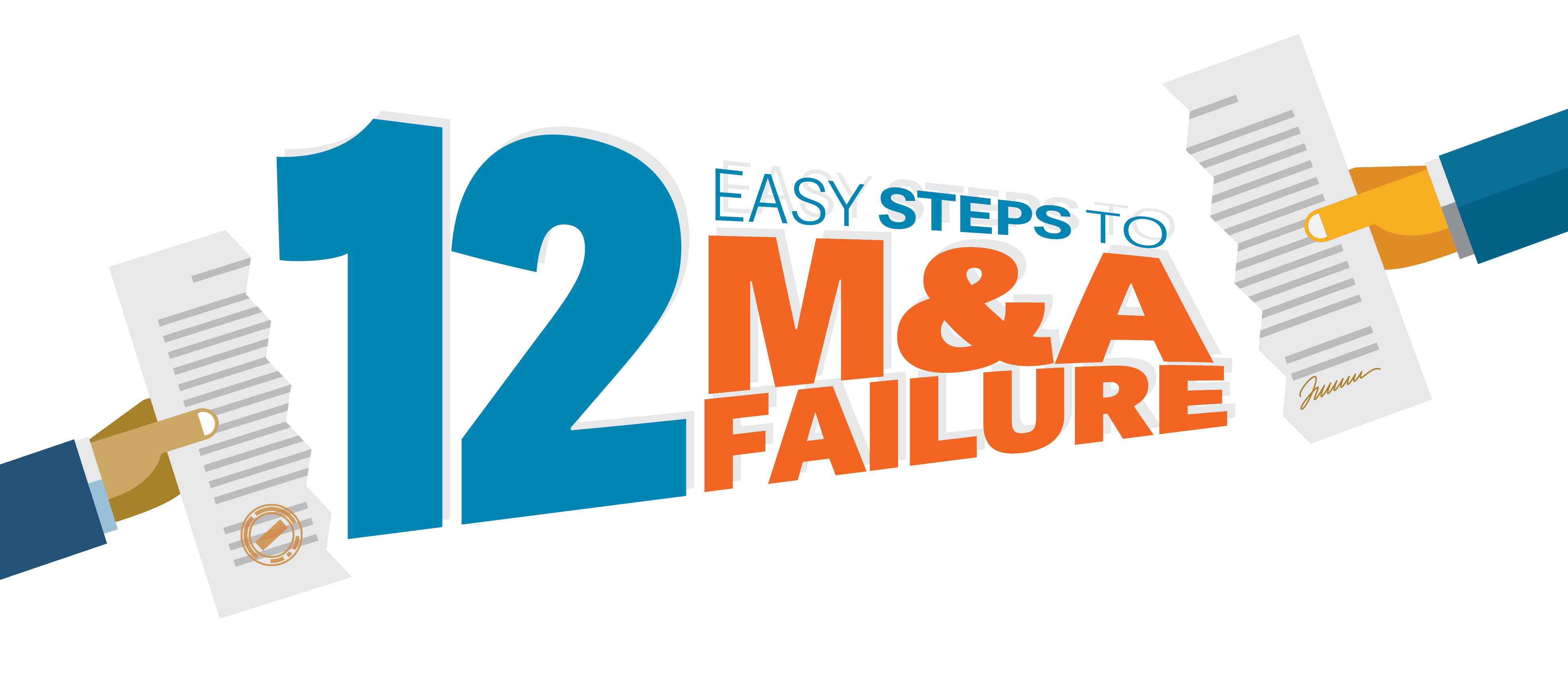For today's global enterprises, Mergers and Acquisitions (M&A) can be an integral strategy for growth, diversity, and remaining competitive. Having a robust M&A strategy can offer several strategic benefits to companies, such as gaining market share, expanding product lines, achieving cost synergies, and diversifying their portfolios in order to gain a competitive advantage.
However, an M&A strategy also comes with a range of challenges that can make the process complex, risky, and maybe not worth it. According to most studies, between 70 and 90 percent of acquisitions fail. Here's how you can ensure that your next M&A deal winds up in the lose column.
12 Easy Steps to M&A Failure

#1 Ignore Cultural Differences
Merging two organizations often involves bringing together employees from very different corporate cultures, values, and ways of doing business. Ignore these cultural differences and you'll be well on your way to ensuring the disintegration of employee morale and productivity.
#2 Don't Bother Aligning Business Processes
Integrating two companies can be a complex and time-consuming process. It includes aligning business processes, IT systems, and organizational structures. Poorly executed integration efforts can lead to operational disruptions, a loss of productivity, and deal failure.
#3 Perform Shoddy Due Diligence
Conducting thorough due diligence is crucial to understanding the financial health and potential risks of a target company. Failing to identify issues like hidden financial issues, legal problems, or tax liabilities will likely lead to costly post-acquisition problems ensuring the failure of the deal.
#4 Ignore Regulatory and Legal Requirements
Depending on the industry, M&A transactions are subject to various legal requirements and regulatory approvals. Failing to navigate these requirements can lead to delays, heavy fines, or even the abandonment of the deal.
#5 Overpay
M&A transactions often require substantial financial resources. Overpaying for a target company or underestimating the costs of integration and other future costs can result in financial strain for the acquiring company.
#6 Ignore Employee Retention Issues
Key employees may leave the company during or after an acquisition due to uncertainty, changes in management, cultural differences, or other disruptions. Failure to retain and motivate key talent is an excellent way to ensure your M&A deal falters or fails.
#7 Ignore Customer and Supplier Relationships
Changes in ownership can disrupt customer and supplier relationships. Failure to ensure continuity in these relationships is an excellent way to destroy revenue streams and supply chains.
#8 Be Impatient
Acquiring companies often expect immediate cost savings or revenue synergies. Failure to realize that these benefits may take longer than anticipated to achieve can lead to knee-jerk reactions and decisions that are detrimental to the success of the deal.
#9 Avoid Transparency
Communicating the rationale and progress of the M&A deal to stakeholders, including employees, customers, and investors (at the right time), is essential for maintaining trust and support. Being surreptitious and secretive is a good way for management to create a climate of mistrust leading to miscommunication, misunderstanding, misconceptions and lack of stakeholder support for the deal.
#10 Ignore the Market
Market dynamics can shift during the course of M&A due diligence. Ignorance of these shifting market dynamics can ensure that a synergy that was once attractive is now no longer viable or worthwhile. The competitive landscape can also change. Ignoring these competitive shifts could give competitors the opportunity to take advantage of the disruption caused by the M&A.
#11 Don't Waste Time on Branding and Identity
Branding decisions can impact customer perception and the market positioning of the new company. A new brand can help differentiate the merged or acquired entity from its competitors and create a distinct identity in the market, helping customers, employees, and other stakeholders understand that the company has undergone a significant change. A new brand can signify a fresh start and help align employees from both companies with a shared vision and culture. Ignoring this importance means a missed opportunity for promoting a sense of belonging and purpose among employees.
#12 Ignore Post-Merger Performance
Ignoring post-merger performance can have significant negative consequences for companies involved in mergers and acquisitions, including financial loss, integration challenges, talent drain, brand and reputational damage, and missed synergies. Ignoring post-merger performance is a great way to destroy deal value.
Successfully navigating M&A deals requires careful planning, due diligence, strong leadership, and effective execution. Many M&A transactions fail to deliver the anticipated benefits due to these complexities, which is why thorough preparation and a well-thought-out strategy are crucial for a successful merger or acquisition.
Virtual Data Rooms in M&A: A Recipe for Success

Virtual Data Rooms have revolutionized the M&A process by offering a secure and efficient platform for the storage, sharing, and collaboration on sensitive documents. These online repositories provide a controlled environment where authorized users can access, view, and collaborate on documents from anywhere in the world. This technology has greatly streamlined the M&A process, making it more efficient and secure.
Enhanced Security
Virtual Data Rooms are designed with robust security features to protect confidential information. They offer encryption, multi-factor authentication, and granular access controls to ensure that only authorized individuals can access sensitive data. In the context of M&A, this security is paramount, as data breaches or unauthorized access can have severe consequences.
Streamlined Due Diligence
Due diligence is a critical phase of the M&A process, where both the buyer and seller scrutinize each other's documents and financials. VDRs simplify this process by providing a structured environment for sharing documents. This streamlines the exchange of information, making due diligence more efficient and reducing the chances of missed details.
Accessibility and Collaboration
Unlike physical documents that require individuals to be in the same location, VDRs enable remote access. This allows M&A teams to collaborate and review documents from anywhere in the world, saving time and resources. It also accommodates international transactions, where key stakeholders may be in different countries.
Cost Savings
The traditional M&A process involves printing and couriering a significant volume of documents, which can be costly and environmentally unfriendly. VDRs significantly reduce these costs, making M&A more cost-effective and sustainable.
Document Tracking and Reporting
Virtual Data Rooms offer tracking and reporting capabilities. This means that administrators can monitor who has accessed documents, when they were accessed, and for how long. This feature provides transparency and accountability throughout the M&A process and can also provide selling companies with valuable deal intelligence.
Virtual Data Rooms have transformed the M&A landscape for enterprises, making the process more secure, efficient, and cost-effective. In a world where data security and streamlined operations are paramount, VDRs are no longer a luxury but a necessity for any company engaged in mergers and acquisitions. By leveraging this technology, enterprises can confidently navigate the complex and high-stakes world of M&A, ensuring the success of their strategic growth initiatives.
ShareVault is the innovation leader in providing virtual data rooms and secure document-sharing solutions that allow businesses to control and track the sharing of confidential information with external parties during due diligence and other critical business processes.
